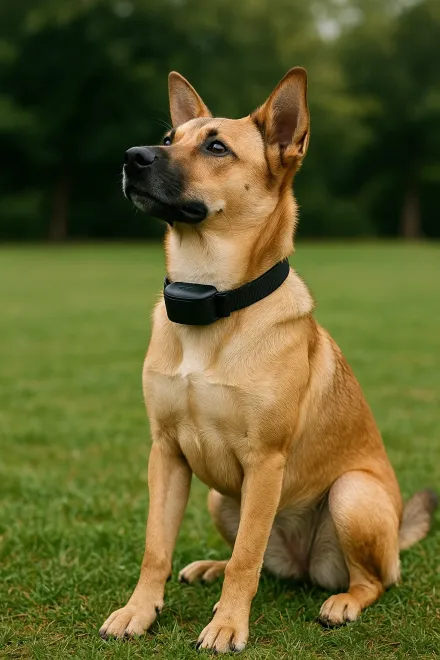Dog Training Collars
Dog training collars are effective tools designed to help you correct unwanted behaviors and improve communication with your pet. When used properly, they allow you to train your dog safely, efficiently, and without causing physical or emotional harm.
In this guide, we show you the different types of training collars available on Amazon—from simple to advanced models—so you can choose the most suitable one based on your dog’s behavior, size, and training goals.
View Dog Training Collars on Amazon
Why Use a Training Collar for Your Dog?
A training collar is a very useful tool for reinforcing basic commands, correcting behaviors like leash pulling, excessive barking, aggression, or disobedience, and improving everyday life with your dog.
Contrary to popular belief, not all training collars are electric or negative. Some use vibration, ultrasonic sound, audible tones, citronella spray, or even positive reinforcement via voice commands or treats. The goal is not punishment, but guidance and learning.
A properly used collar can be a key asset to promote balanced behavior—especially for energetic breeds, adopted dogs, or those with socialization issues. However, it should always be used with common sense, respect, and preferably under guidance from a professional dog trainer.
Types of Dog Training Collars and Their Uses
- Vibration collars: Emit a gentle vibration to get the dog’s attention. Great for reinforcing commands without causing stress.
- Sound or ultrasonic collars: Emit an audible (or high-frequency) tone to interrupt unwanted behavior.
- Citronella spray collars: Release a small citronella burst to discourage behaviors. Non-harmful and popular with small dogs.
- Electric collars (E-collars): Deliver a low-level adjustable shock. Should only be used by professionals or under expert supervision.
- Anti-bark collars: Specifically designed to control excessive barking using one or more of the above methods.
- Remote-controlled collars: Allow the owner to send a signal (vibration, sound, or light) when the dog misbehaves. Ideal for long-distance training.
Selecting the right type depends on your dog’s temperament, the behavior you want to address, and your preferred training method.


Tips for Choosing the Best Dog Training Collar
When choosing a training collar, consider these factors to ensure it’s safe, effective, and appropriate for your dog:
- Dog size and weight: Make sure the collar is sized correctly and suitable for your dog’s weight. A strong collar on a small dog can be counterproductive.
- Type of stimulation: For most dogs, sound, vibration, or citronella are sufficient. Avoid electric shocks if you lack experience or professional advice.
- Range: If training in open areas or parks, choose a model with good range (some go up to 300 meters).
- Battery life: Check for rechargeable batteries with good autonomy. Some last days or even weeks on a single charge.
- Waterproofing: For water-loving dogs, look for waterproof or submersible models.
- Reviews: Check Amazon reviews to see real experiences from owners with dogs similar to yours.
Frequently Asked Questions About Dog Training Collars
Are training collars safe?
Yes, as long as they are used correctly and the right model is selected based on the dog’s size and temperament. Vibration, sound, or citronella collars are designed to be safe and non-invasive. Electric stimulation collars can also be safe when used on low settings, under professional guidance, and with clear training goals. Misuse—like leaving it on all day or using it for punishment—can cause harm.
Can I use one on a puppy?
Generally, training collars are not recommended for puppies under 6 months old, as they are still developing physically and emotionally. During this stage, it’s better to train using games, positive reinforcement, and routines. If your puppy shows problematic behaviors, consult a professional trainer before using tools adapted to their age.
Will the collar train my dog automatically?
No. A training collar is not a magical fix. It's just a tool that reinforces commands or corrects behaviors, but it must be part of a consistent training plan. Positive reinforcement, clear communication, and a strong bond with your dog are essential for success.
Can it harm my dog?
Modern training collars are designed to be safe when used responsibly. Risk arises when high-intensity stimuli are used, the collar is placed incorrectly, or it’s left on without supervision. Always read the manual, start with the lowest setting, and observe your dog’s response. The aim is not to cause pain, but to get attention or interrupt behavior.
How long should I use a training collar?
It should only be used during specific training sessions—not all day. Avoid using it during relaxed walks or when the dog is unsupervised at home. Often, a few weeks of proper use is enough to correct a behavior. Once your dog learns the expected behavior, you can switch to praise or treats.
What’s the best collar for a dog that pulls on the leash?
If your dog pulls excessively during walks, consider a no-pull harness or a training collar with vibration or sound. These help redirect attention and teach your dog to walk calmly. Combine it with reward-based training: praise when walking nicely, stop when pulling, and repeat patiently. Avoid prong or choke collars—they can cause stress and long-term issues.
